Yucca and palm fantasyland at John Fairey Garden
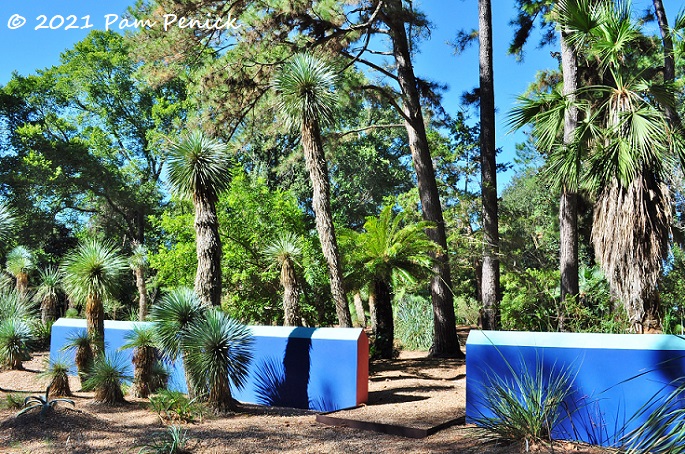
I’d been to The John Fairey Garden (formerly Peckerwood Garden) a half-dozen times before my late-October visit with Loree Bohl of Danger Garden, who was in town to give a Garden Spark talk. Frustratingly, I’d never toured the dry garden, though I’d glimpse its bristling yuccas and iconic blue wall in the distance. A cypress-kneed creek that divides the main gardens from the dry garden was always flooding, and a homemade footbridge was considered treacherous for visitors.
But this time I got across! Executive director Randy Twaddle led Loree and me across the old, sketchy footbridge and set us loose in the dry garden, inviting us to return across a brand-new bridge that was receiving its finishing touches that day. With a sense of triumph, I set off to explore.
Dry Garden
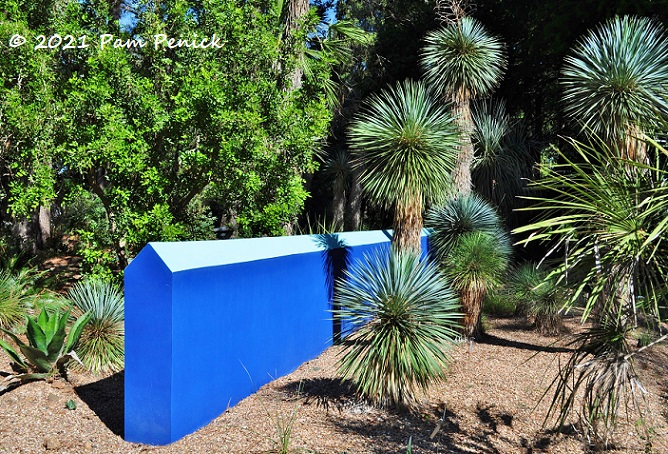
First, that wall! Photos of it partly inspired my own cobalt stucco wall. In profile, with that peaked top, it looks like a child’s drawing of a house. A lighter shade of blue colors the peak, emphasizing the shape.
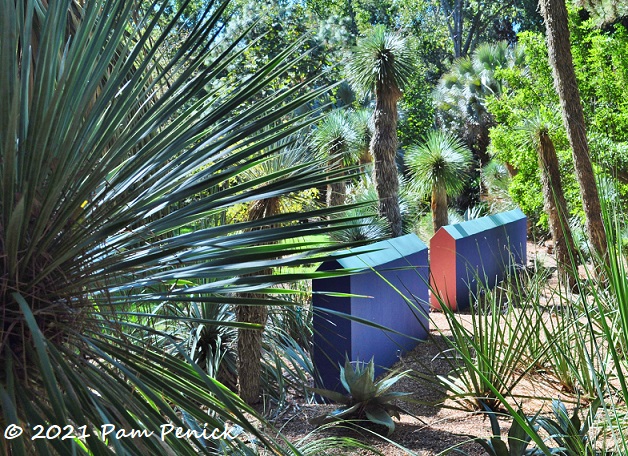
And — surprise! — pink is revealed in the “center” of the wall, as if a giant bread knife sliced out a chunk to run a path through.
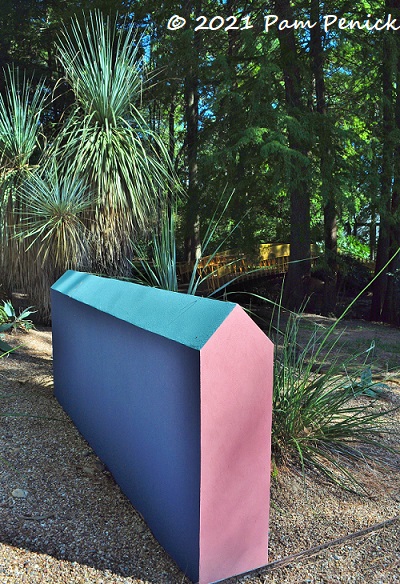
A wall this bold deserves equally bold plants, and the dry garden delivers.
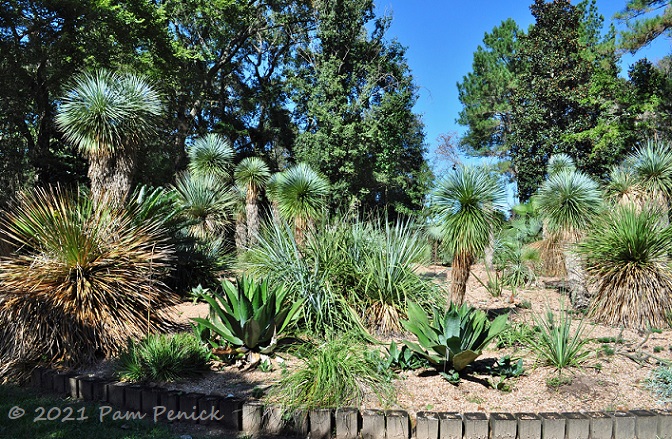
Beaked yuccas galore stand erect like a colony of meerkats on the African plain. Squat, spiky agaves and spherical strappy sotols (with browned foliage from the February snowpocalypse) add to the otherworldly scene.
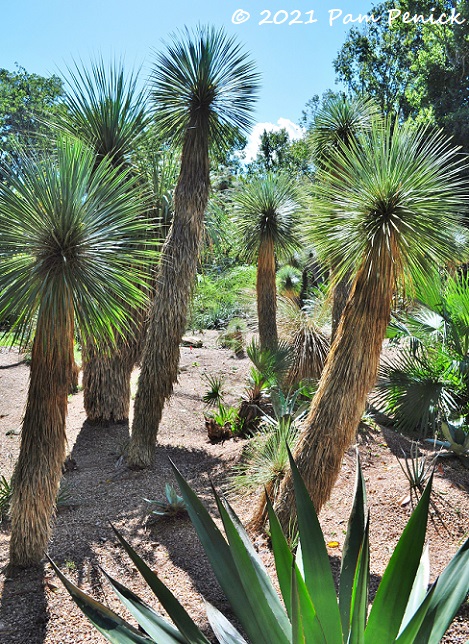
Just look at these beauties — like blue-green fireworks going off all around you.
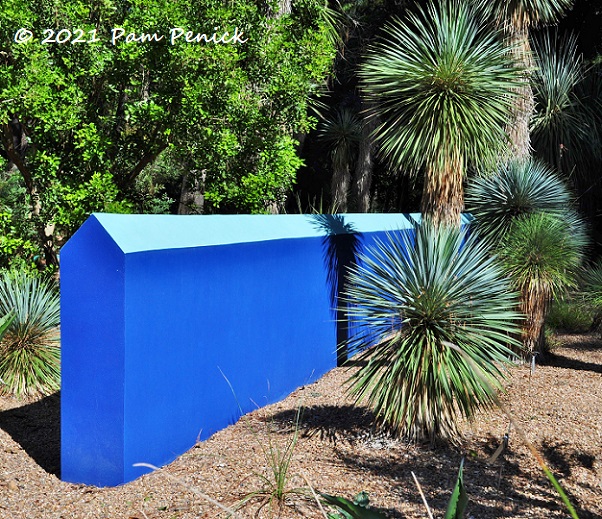
Where the yuccas crowd along the blue wall, their spiky-headed shadows drape across it.
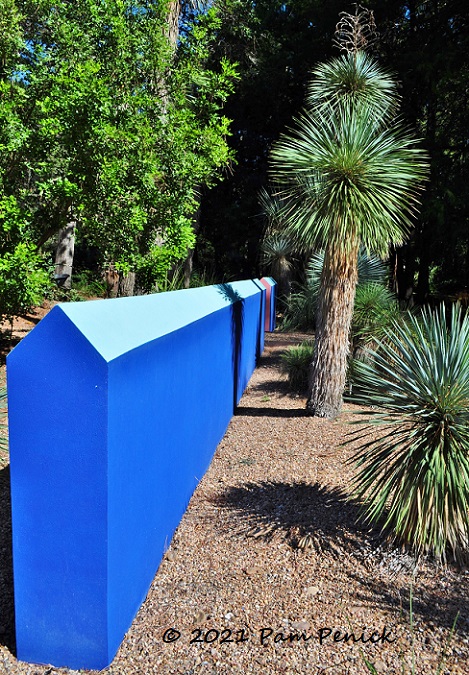
Bristly shadows show up well against the tan gravel too.
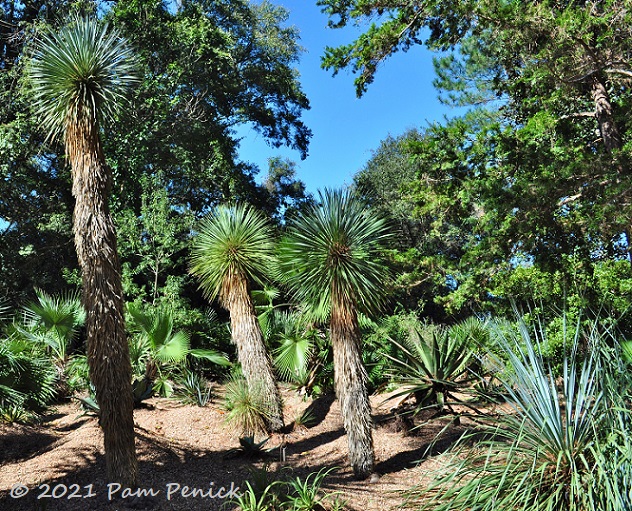
Hempstead, an hour west of Houston and two hours east of Austin, receives about 43 inches of rain a year. To keep dry-loving plants from rotting, the garden’s founder, John Fairey, would plant them on gravelly mounds for drainage.
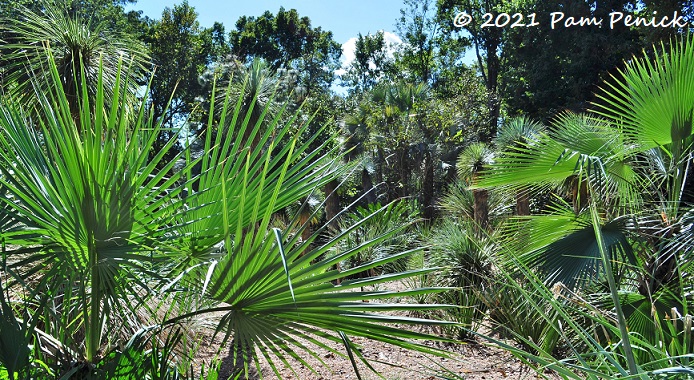
Palms thrive here too, even after the horrible February freeze. I’m sure some palms were lost, but many remain.
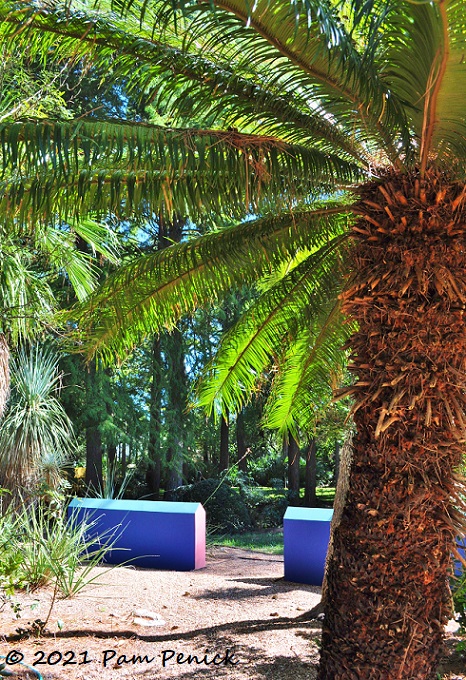
Cycads too, including this giant.
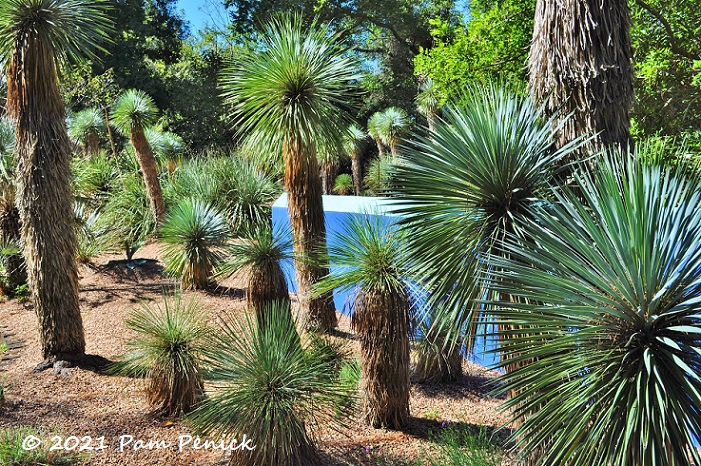
It’s easy to anthropomorphize beaked yuccas. Those straight trunks and big, round heads always remind me of people. Hello there!
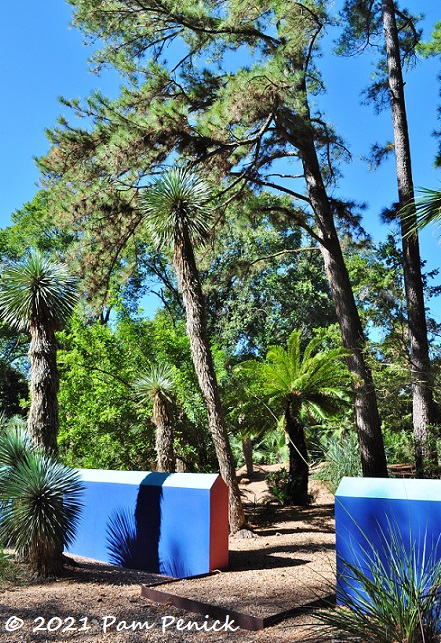
Some of the yuccas are tree sized.
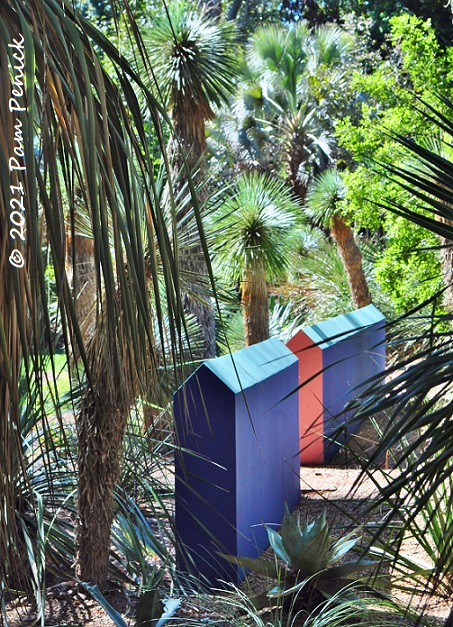
This monochromatic garden is about texture and form, not flowers or contrasts of foliage color or anything like that. And the blue wall complements and grounds all those shimmering, soaring, blue-green plants.
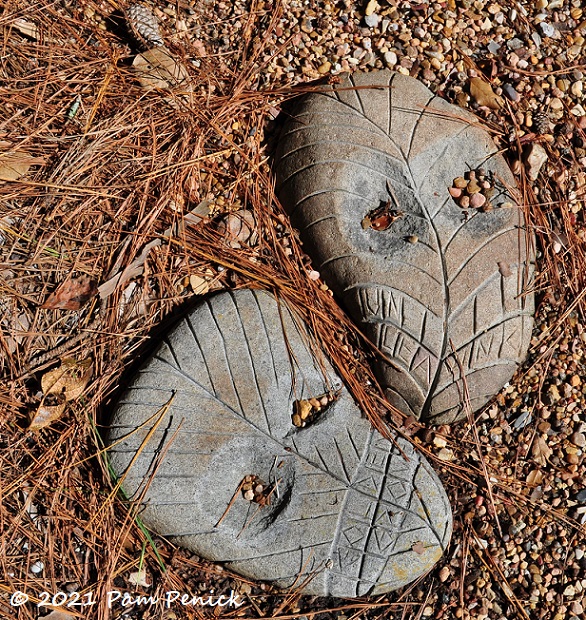
John Fairey collected pieces by sculptor Marcia Donahue, including these leaf faces. Carved words in their teeth read golden grove on the left and something I can’t decipher on the right. Leaf maybe?
New footbridge
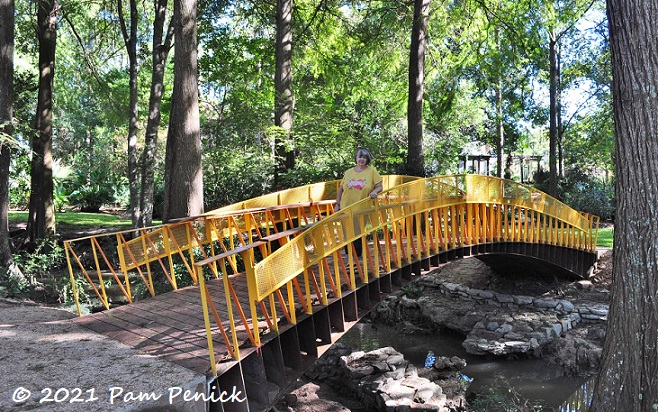
Crossing the creek to return to the main gardens, I took a photo of Loree on the new yellow footbridge. You can read about the bridge’s design, and how it will hold up when the creek inevitably floods, in the link.
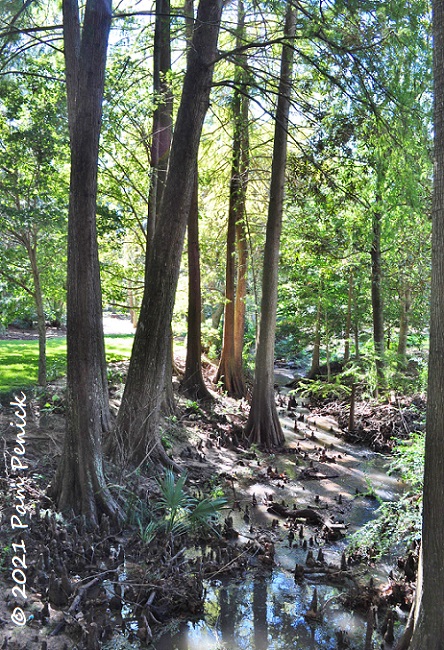
The creek, placid and knobbed with bald cypress knees
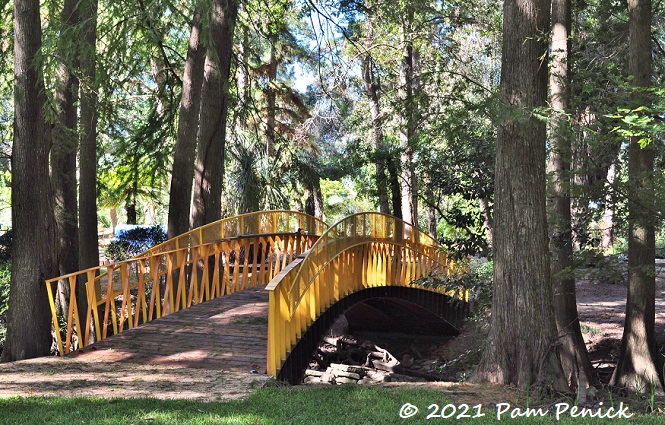
It’s exciting to know that future visits to the dry garden won’t be thwarted, thanks to the new bridge.
Woodland Garden
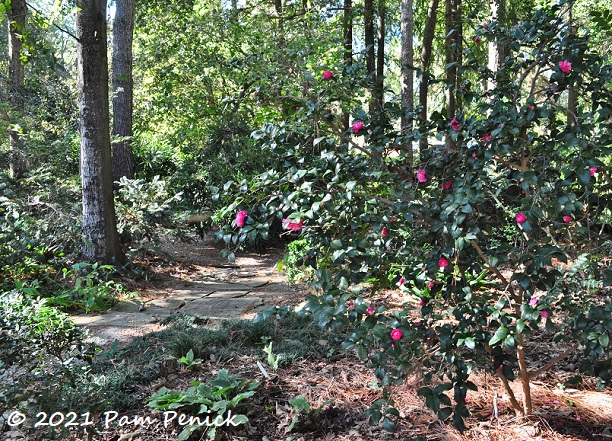
From the sunny, gravelly dry garden you cool off in a shady woodland garden blanketed with pine needles. An early camellia, hot pink, was flowering. One of these days I’ll visit in November-December to see their 70+ camellia cultivars in bloom.
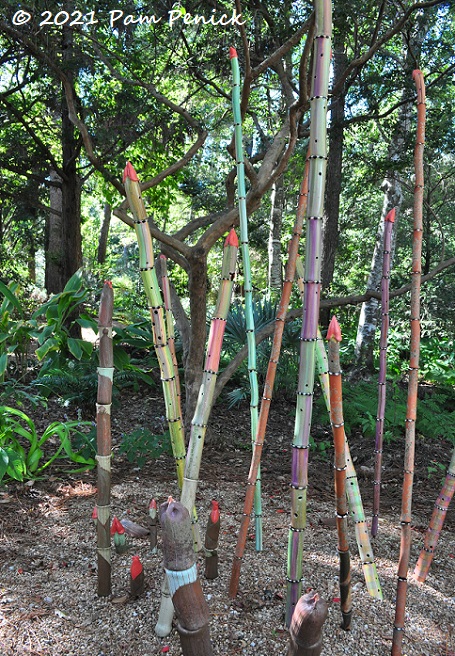
A Marcia Donahue sculpture of colorful bamboo “grows” in a small clearing. (For my visit to Marcia’s personal garden in Berkeley, California, click here.)
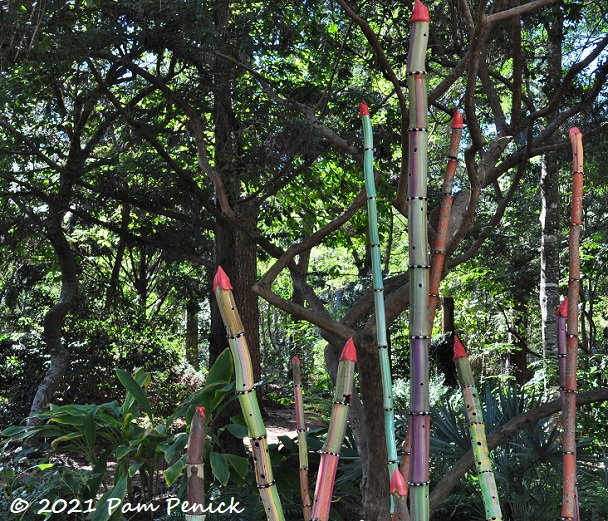
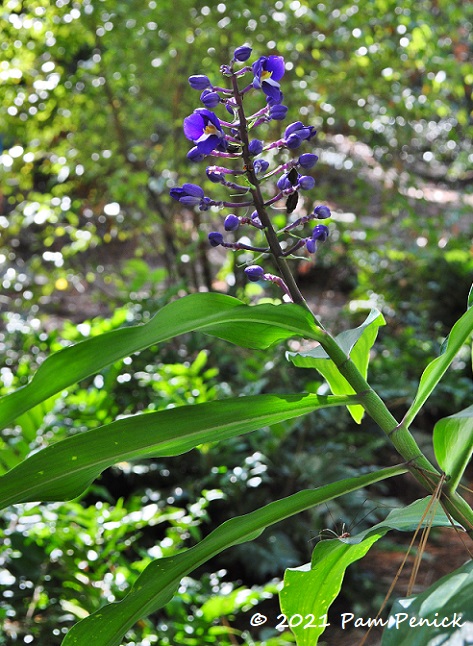
A blue ginger (Dichorisandra thyrsiflora) in bloom caught my eye.
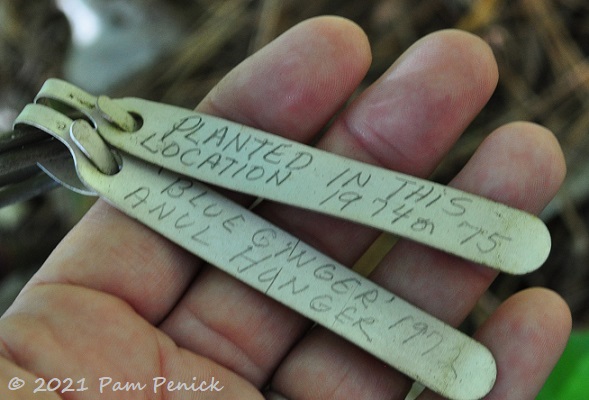
As did its detailed plant labels. A penciled inscription on one metal tag reads, “Planted in this location 1974 or 75.”

“Oldest perennial in garden,” reads another.
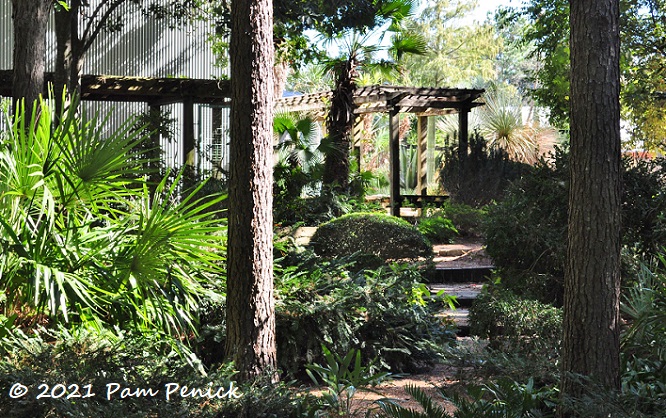
This dappled-light, stepped-up passage through palms, boxwood, and columns of tree trunks is one of my favorites moments in the garden. Ahead you glimpse the corrugated metal siding of the house that John Fairey built.
Arbor transition
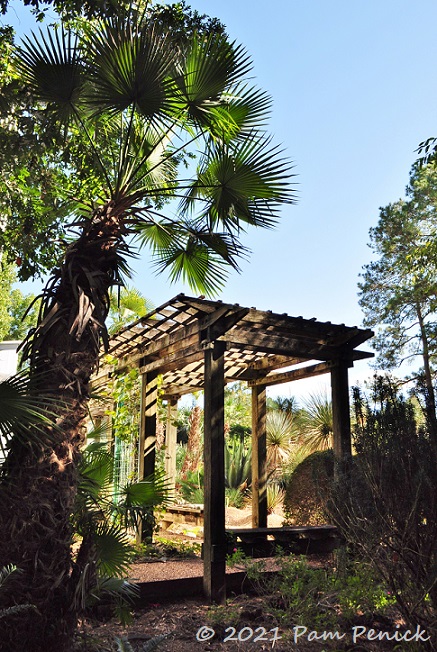
A long wooden arbor creates a hallway between the shady woodland and the sunny dry garden in front of the house.
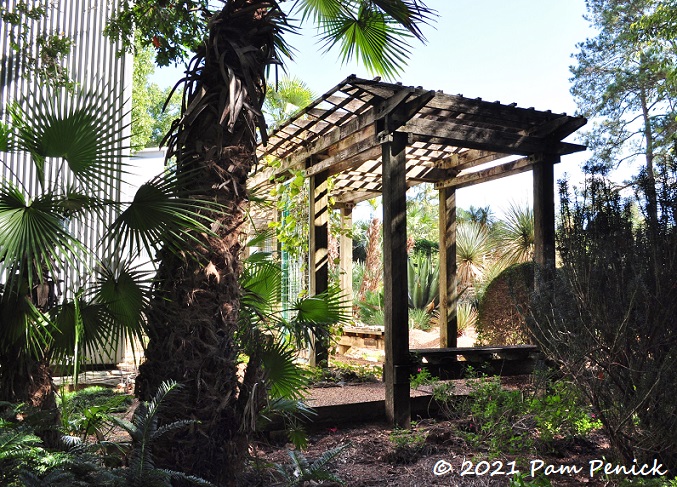
Palm fronds dazzle against the metal siding, and beyond you see spiky yuccas and agaves.
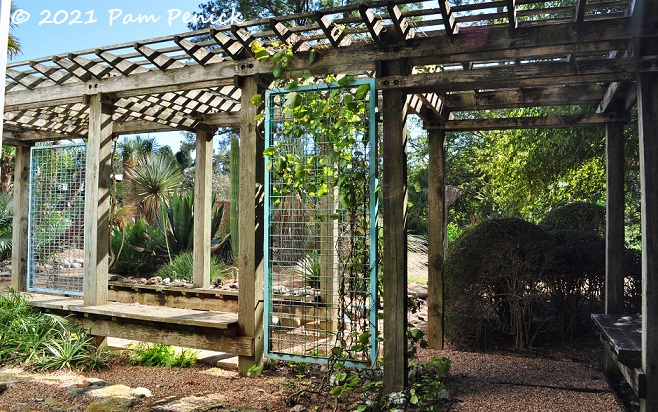
Inset panels of blue-green, wire-mesh trellising brighten the arbor and give vines a place to climb.
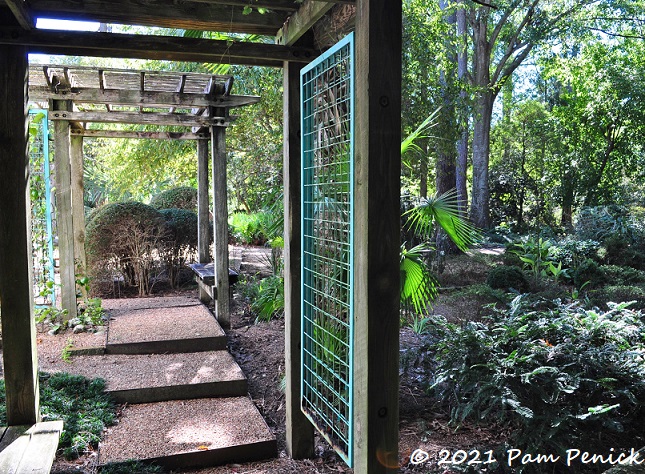
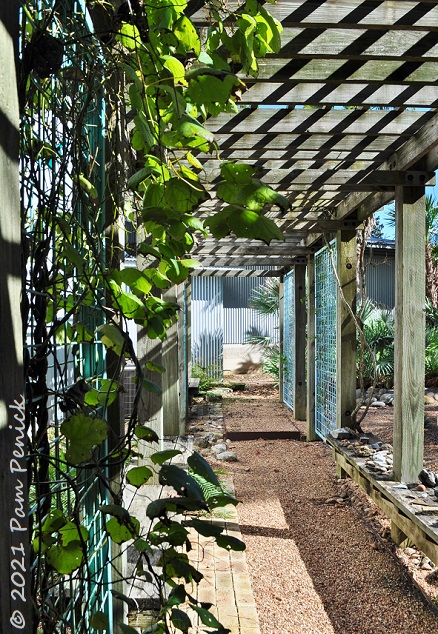
The long view
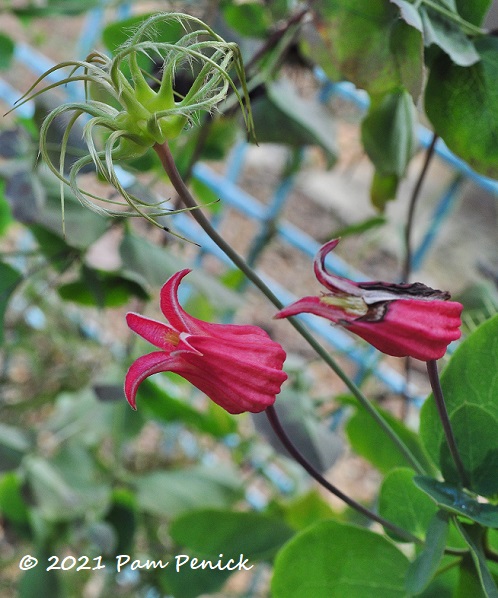
Scarlet clematis (Clematis texensis), a Texas native
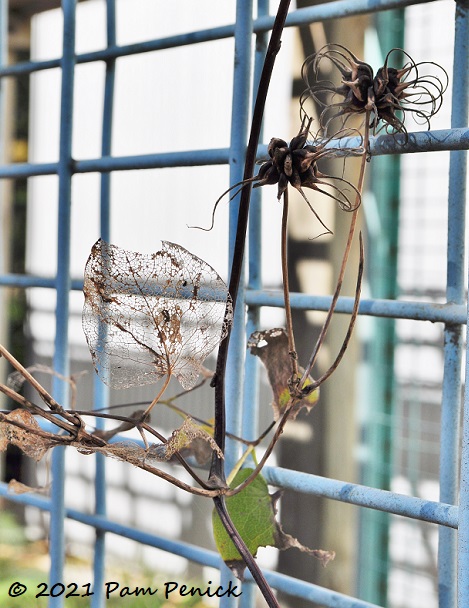
And gone to seed, with a diaphanous skeleton of a leaf hanging on
House Garden
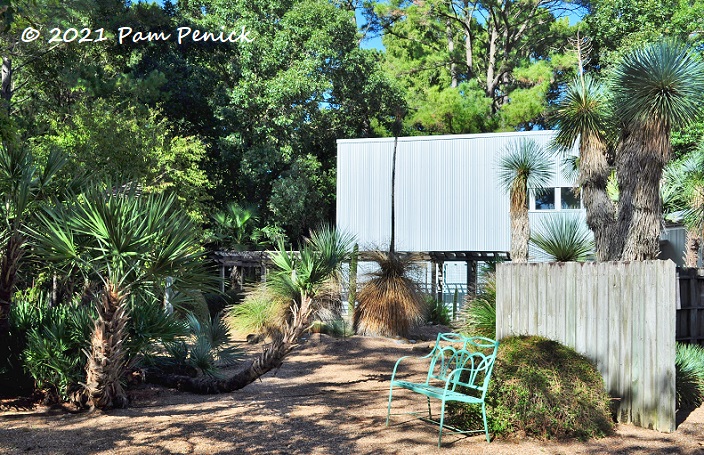
Saw palmetto (Serenoa repens) trunks with new-sprouted fronds tell the tale of freeze damage, as do bronzed masses of dasylirion.
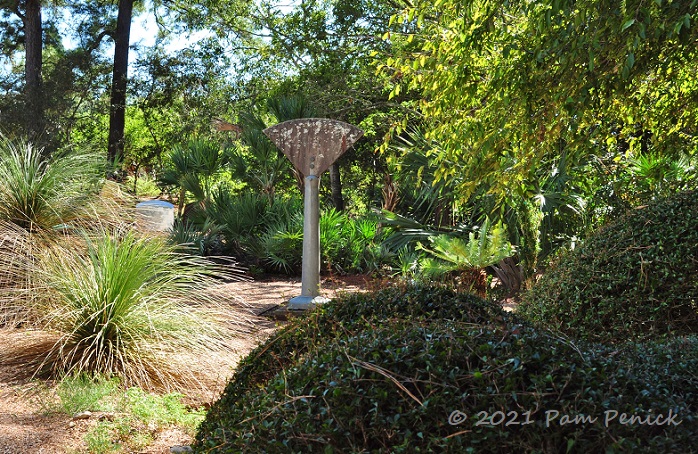
But overall the garden was green and lush thanks to hardy yuccas, resprouting palms, boxwoods, and much more.
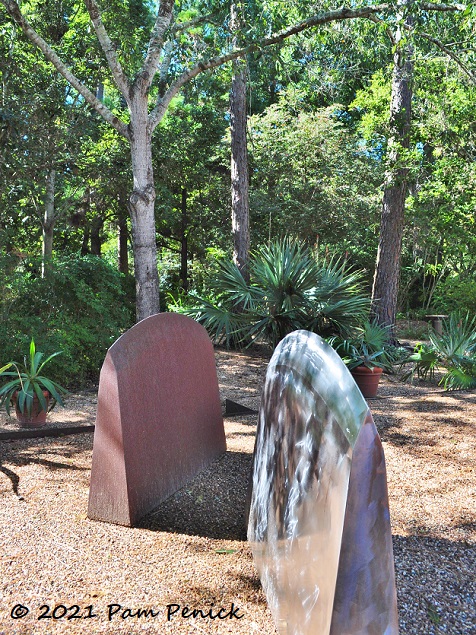
Two steel sculptures, one shiny silver, the other matte rust, draw the eye at the far end of the house garden.
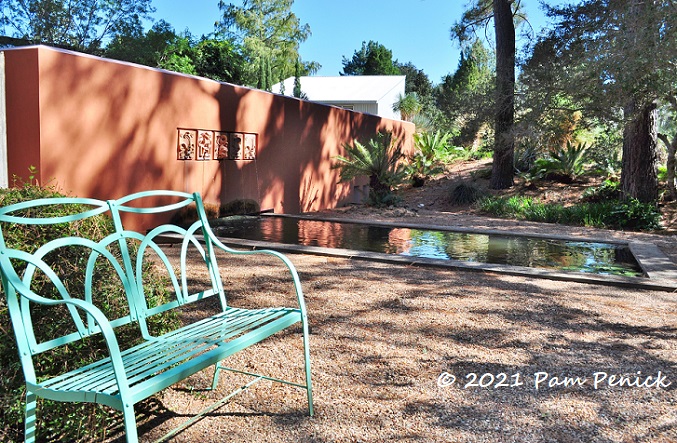
Another colorful wall makes a grand statement here. On each side, face tiles act as scuppers, spitting water into a rectangular reflecting pond.
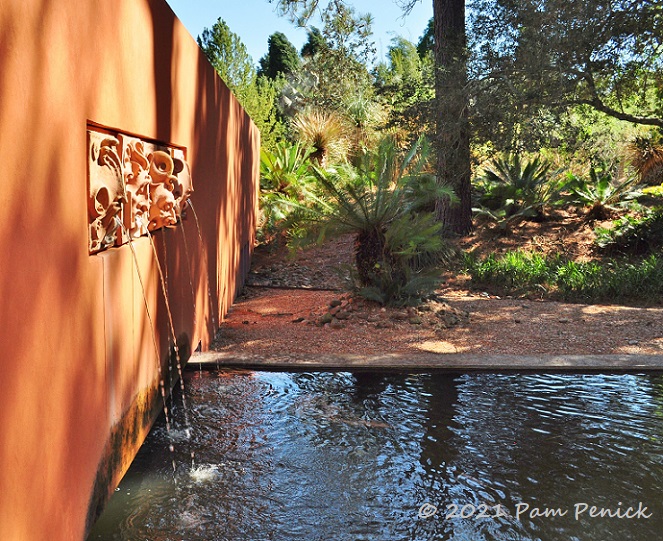
The warm terracotta of the wall glows on a sunny day.
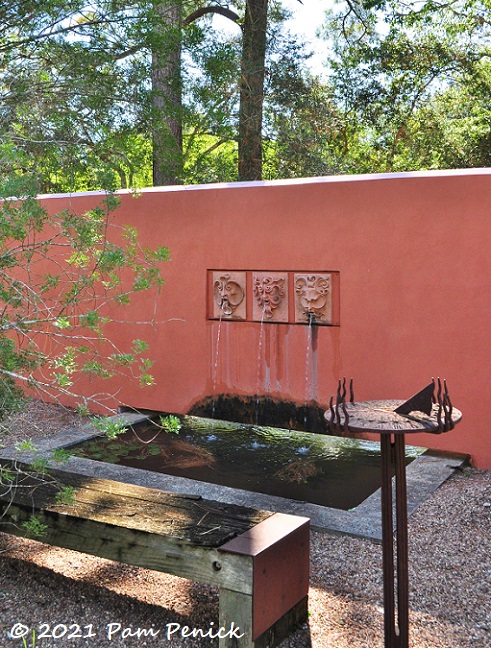
The inner view, with a short section of the reflecting pond extending under the wall.
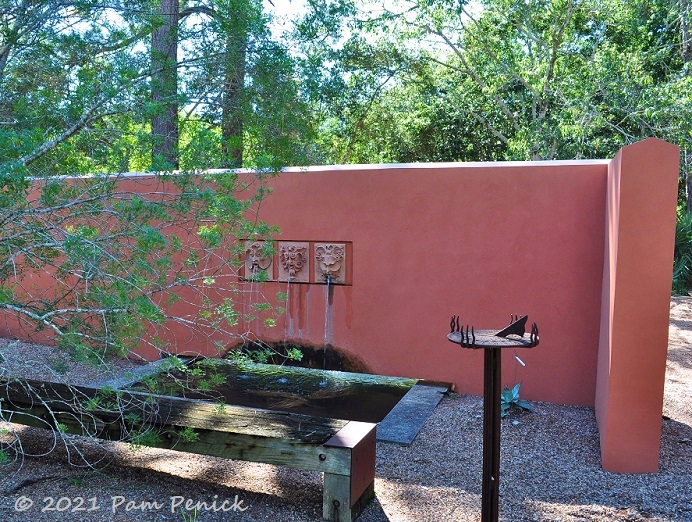
A long wooden bench invites you to sit and enjoy the face scuppers.
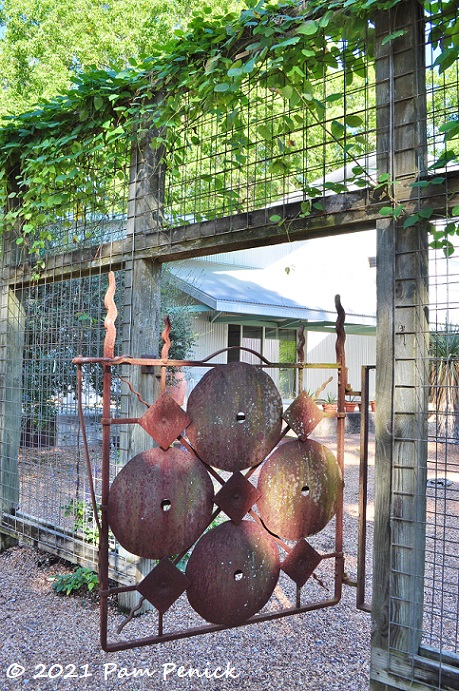
A tall trellis fence with a plow-disc gate marks the inner sanctum of the house garden.
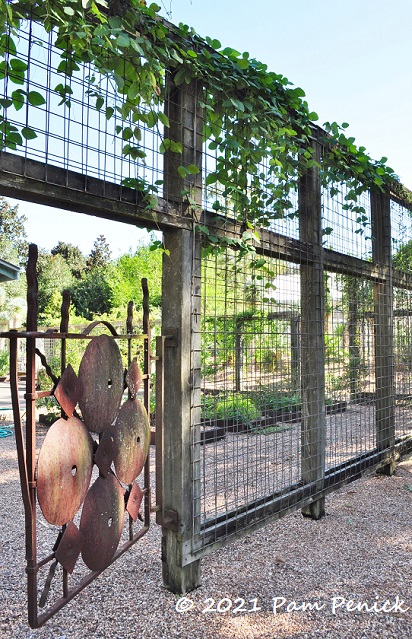
Vegetable beds are laid out in the gravel patio inside the fence.
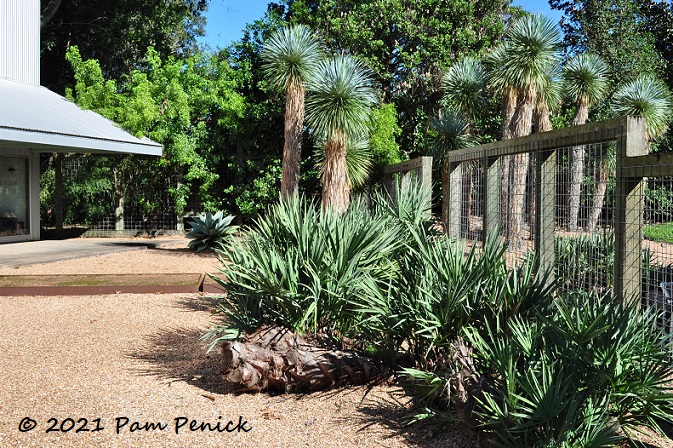
Horizontal palmetto trunks have been cut back, casualties of the freeze, but new growth appears along the top.
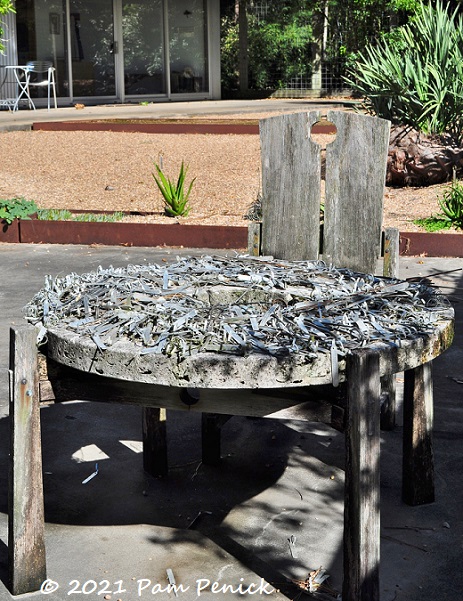
A round patio table displays a tribute to plants that have passed on.

Making a statement with “dead” plant tags — that’s clever. After all, gardening is always an experiment, and plants die. It’s just a fact.
House
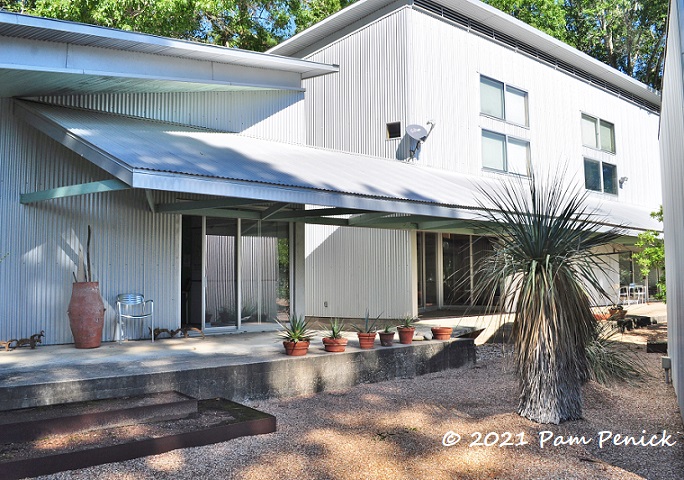
The metal-sided house and detached studio are strikingly contemporary for a rural garden. An awning-style roof connects the buildings and their separate concrete porches.
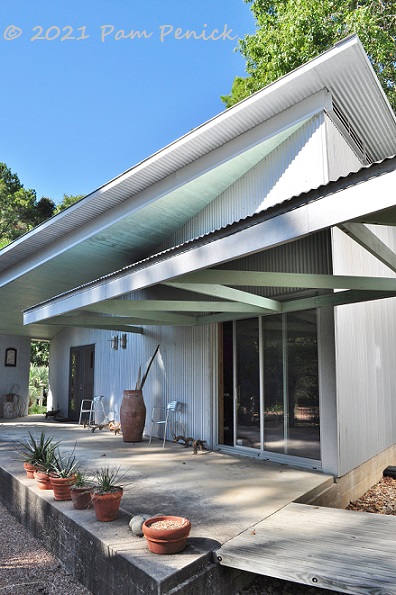
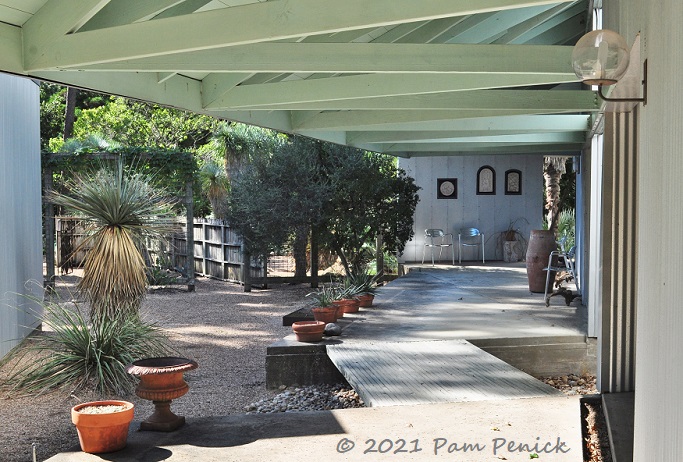
A wooden bridge zigs across the opening between the porches. I love the deep, trussed porch roof.
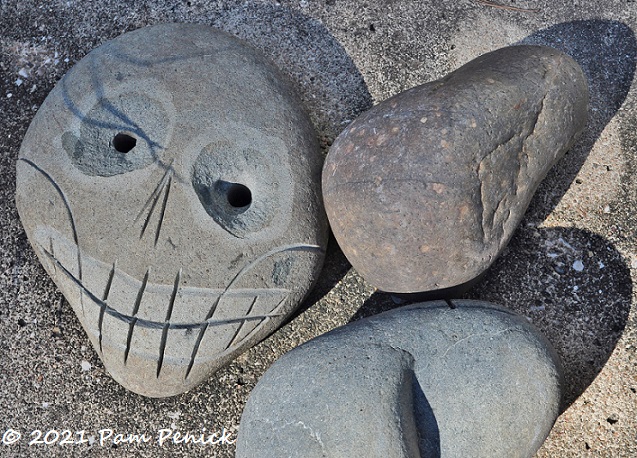
A grinning rock skull — another Marcia Donahue piece, I believe
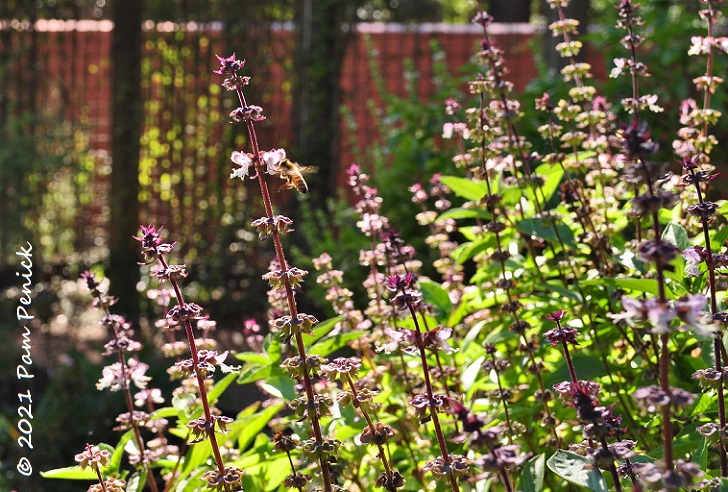
Bees were a-buzzing in the basil.
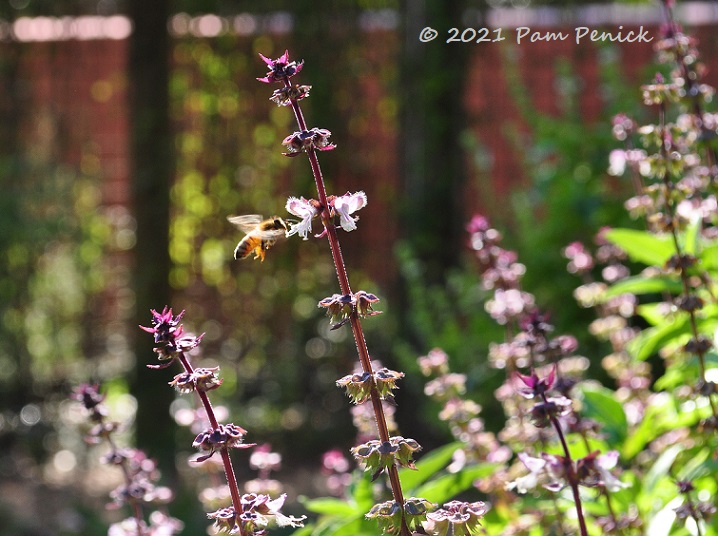
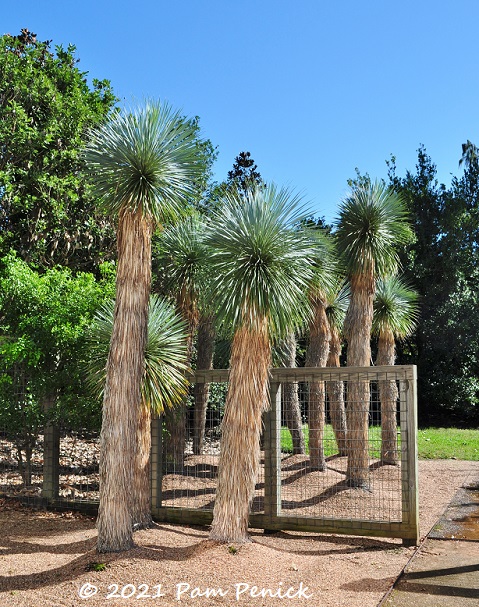
More meerkats beaked yuccas on each side of an open fence separating the house garden from the more public spaces.
Perennial garden
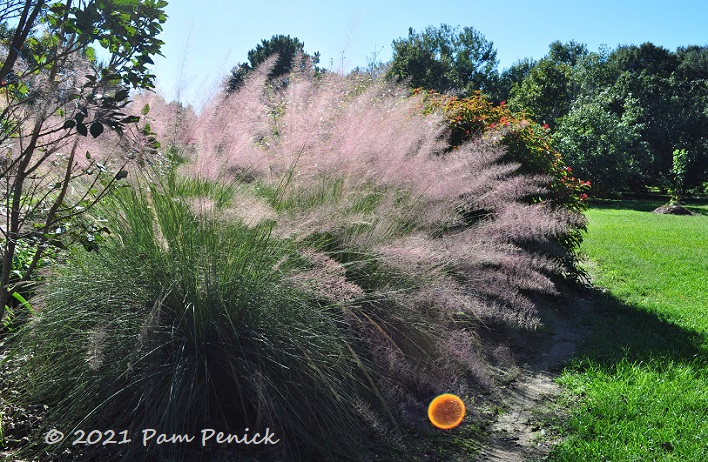
Showy ‘Pink Flamingo’ muhly grass, a natural hybrid of Gulf muhly and Lindheimer muhly, was discovered here years ago. Today you can find it for sale at nurseries.
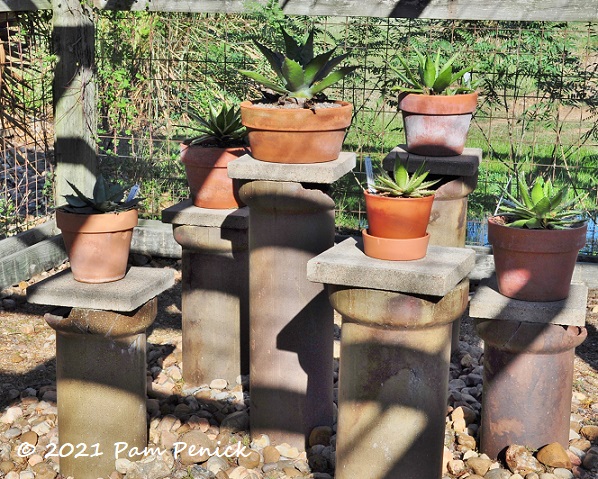
Speaking of nurseries, The John Fairey Garden operates one near the garden entrance, where you can find all sorts of unusual plants, including many collected by John on his long-ago plant-hunting expeditions. For some reason, I didn’t take a photo of the sale tables. But I did take one of potted agaves displayed on plinths made from paver-topped pipes.
Mosaic wall
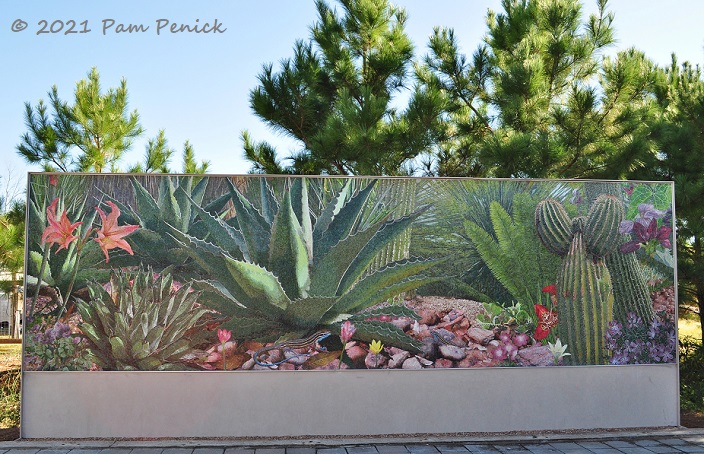
Another new feature at the garden is a beautiful mosaic-tile wall mural by Houston artist Dixie Friend Gay. It depicts a spiky garden scene from a lizard’s-eye view.
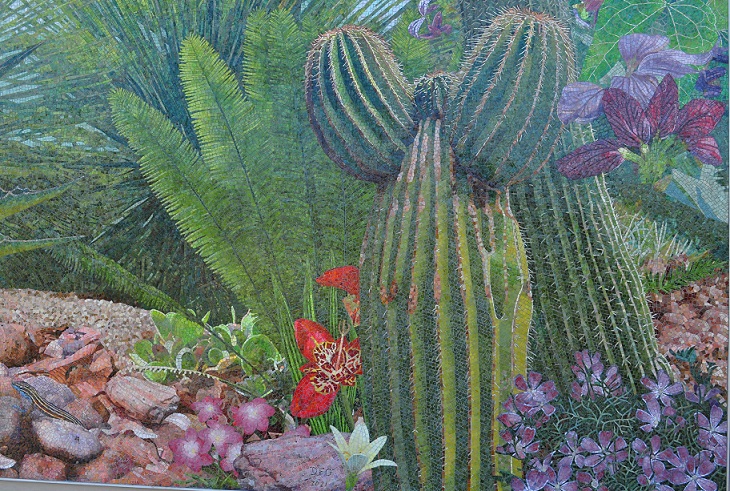
Gay has also created several sculptures at Mueller neighborhood in Austin, which are worth a visit.
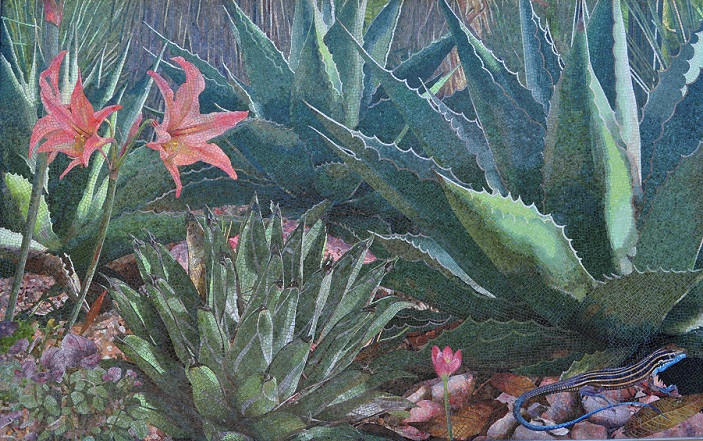
She has a gift for showing plants and animals from unique perspectives.
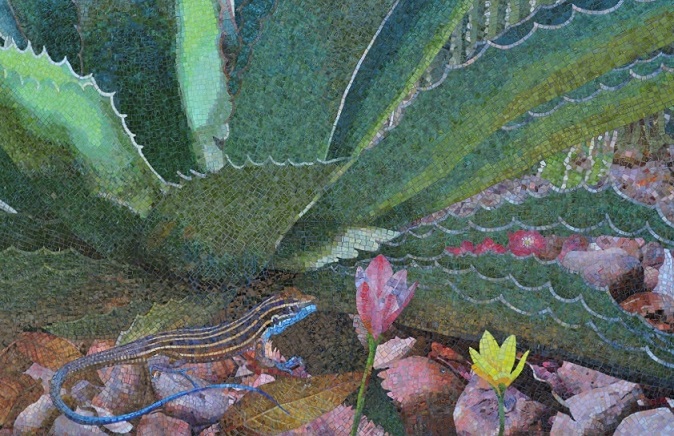
If you’d like to tour The John Fairey Garden yourself, join their email list or check their online calendar for upcoming Open Days. You can also arrange a private tour for groups of 5 or more.
To learn more about founder John Fairey and the plant-hunting in Mexico that inspired his garden, read my article in Garden Design magazine.
__________________________
Digging Deeper
Need design help with your yard? Hire me as your personal garden coach! Maybe you need replacement plant ideas after the big freeze. Or maybe your landscaping has grown tired, and you want fresh curb appeal. Or perhaps you’re ready to get rid of some lawn and create a pollinator garden, bird habitat, or hangout space for you and your friends. I’m here to help! Contact me to let me know what’s going on, and let’s figure it out together. My range is Austin and suburbs within a 25-min. drive of NW Austin, but I’m flexible and can travel farther with a surcharge, so let me know where you are. Weekday morning appts. only.
Come learn about gardening and design at Garden Spark! I organize in-person talks by inspiring designers, landscape architects, authors, and gardeners a few times a year in Austin. These are limited-attendance events that sell out quickly, so join the Garden Spark email list to be notified in advance; simply click this link and ask to be added. Season 8 kicks off in fall 2024. Stay tuned for more info!
All material © 2025 by Pam Penick for Digging. Unauthorized reproduction prohibited.


This is a wonderful tour of that garden! Between your prose and your photos, a person feels that they know the garden. Thank you for this! My husband and I went on one of the tours of it many, many years ago. It is exciting to see how it has grown and all the changes that have gone on. (Having a solid bridge to the other side of the creek is a big plus!) And I’m glad to see that it got through the Big Freeze pretty well.
Speaking of the Big Freeze, I was posting earlier this year about how dreary and brown Houston was with all the dead plants, and a Friend did a ‘LOL’ and said that their entire winter was about brown, dead-looking plants. And it made me appreciate how green Houston normally is in winter. Further into that same post and I was saying about how, right after the freeze, people were so starved for greenery that they congregated at the trucks delivering to nurseries and were snatching plants as soon as they hit the ground, if not right out of the nursery employees’ hands/arms. She replied with something I had never given any thought to – that the nurseries in the North close for Winter. Hahah, I don’t know why it never occurred to me!
That does put it all in perspective, doesn’t it? Every extreme is relative to what we’re used to and prepared for. But having had a taste of “real” winter I’m more grateful than ever for our usual green winters here in Texas.
What a sumptuous treat with my coffee this Friday morning. And thanks for including rainfall averages — it really deepens appreciation of his specific vision and execution. The height of those yuccas is astonishing. Ever since I’ve heard the beaked yucca termed a “monsoon” succulent, it’s helped to understand their typically much smaller size in SoCal. I need to check if there’s a biography of Fairey — obviously a man of rare vision and boundless energy! Your GD article is a wonderful resource too.
I’d never heard the term “monsoon succulent,” Denise. That makes perfect sense, though, since beaked yucca is a West Texas native, where they have summer monsoon rains. I’m just glad this plant adapts so well to Central Texas, where we do not have monsoons but rather spaced-out rain throughout the year.
It was wonderful to relive this sunny warm garden visit with you on this foggy cold morning. I feel so lucky that a part of the garden you’d longed to see was just open for me to visit on my first (only?) trip to this garden.
I’m really glad you got to see it with me, Loree. You were probably one of the first non-staff members to traverse the new bridge!
Love all the Yuccas – and that fantastic mural. However, my brain short-circuited when I saw 43 inches of rain mentioned.
Hah! Yes, I suppose as a Los Angeles gardener, that rain total must look pretty luxurious.
Interesting and educational. Some of the the Y. rostratas are so tall–have not seen that ever. Thank you.
Like Kris, I’m trying to comprehend “43 inches” and “rain” in the same sentence. Wha??!!!?!!?? That would be three years worth here.
I’ve never seen rostratas that tall either. Must be all the rain! And how about this for mind-boggling: Houston, just an hour east of Hempstead, gets 50 inches of annual rainfall on average — with corresponding humidity, thanks to its proximity to the Gulf of Mexico.
Love the comparison with meerkats! Really interesting post. I’ve read about this garden and now feel like I’ve seen it.
Thanks, Pat. There’s actually another whole section of the garden I didn’t photograph, mainly because it doesn’t interest me as much as the dry gardens. It’s an arboretum with an extensive collection of oak species and other rare trees that Fairey collected from Mexico and beyond. For plant nerds, there’s a lot more to the garden than I’ve been able to convey. Being a design nerd more than a plant collector myself, I’m really there for the aesthetic of the dry garden and woodland garden.